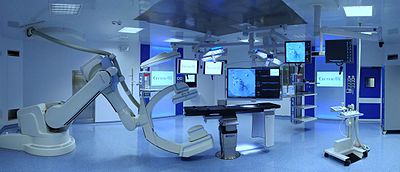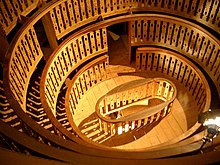Operating theater
This article needs additional citations for verification. (June 2017) |

An operating theater (also known as an operating room (OR), operating suite, or operation suite) is a facility within a hospital where surgical operations are carried out in an aseptic environment.
Historically, the term "operating theatre" referred to a non-sterile, tiered theater or amphitheater in which students and other spectators could watch surgeons perform surgery. Contemporary operating rooms are devoid of a theatre setting, making the term "operating theater" a misnomer.
Operating rooms[]
Operating rooms are spacious, easy to clean in a cleanroom, and well-lit, typically with overhead surgical lights, and may have viewing screens and monitors. Operating rooms are generally windowless, though windows are becoming more prevalent in newly built theatres to provide clinical teams with natural light, and feature controlled temperature and humidity. Special air handlers filter the air and maintain a slightly elevated pressure. Electricity support has backup systems in case of a black-out. Rooms are supplied with wall suction, oxygen, and possibly other anesthetic gases. Key equipment consists of the operating table and the anesthesia cart. In addition, there are tables to set up instruments. There is storage space for common surgical supplies. There are containers for disposables. Outside the operating room, or sometimes integrated within, is a dedicated scrubbing area that is used by surgeons, anesthetists, ODPs (operating department practitioners), and nurses prior to surgery. An operating room will have a map to enable the terminal cleaner to realign the operating table and equipment to the desired layout during cleaning. Operating rooms are typically supported by an anaesthetic room, prep room, scrub and a dirty utility room.[1]
Several operating rooms are part of the operating suite that forms a distinct section within a health-care facility. Besides the operating rooms and their wash rooms, it contains rooms for personnel to change, wash, and rest, preparation and recovery rooms(s), storage and cleaning facilities, offices, dedicated corridors, and possibly other supportive units. In larger facilities, the operating suite is climate- and air-controlled, and separated from other departments so that only authorized personnel have access.
Temperature and surgical site infections (SSI). The current operating room design temperature is between 65 and 75 °F (18 and 24 °C).[2][3] Operating rooms are typically kept below 73.4 °F (23 °C) & room temperature is the most critical factor in influencing heat loss.[4] Surgeons wear multiple layers (surgical gowns, lead aprons) and may perspire into an incision if not kept cool and may decrease concentration and increase errors.[4] Higher temperatures increased subjective physical demand and frustration of the surgical staff.[2] One option is to heat the patient to prevent surgical site infections (SSI) and keep the surgical team cool. There is a 3 fold increase in infection for every 1.9 degree Celsius body temperature decrease[5] and radiation is the major cause of heat loss in patients, and convection (through air) is the second cause of heat loss.[6] In the first hour it is common for healthy patient’s temp decrease 0.5-1.5 °C as anesthesia causes rapid decrease in core temperature.[6] One study found that the most efficient method of maintaining normothermia included using warm wraps and a heating blanket (commercially known as a Bair Hugger) [6]. Additionally, pre-warming for thirty minutes may prevent hypothermia.[4]
Operating room equipment[]
This section does not cite any sources. (July 2019) |

- The operating table in the center of the room can be raised, lowered, and tilted in any direction.
- The operating room lights are over the table to provide bright light, without shadows, during surgery.
- The anesthesia machine is at the head of the operating table. This machine has tubes that connect to the patient to assist them in breathing during surgery, and built-in monitors that help control the mixture of gases in the breathing circuit.
- The anesthesia cart is next to the anesthesia machine. It contains the medications, equipment, and other supplies that the anesthesiologist may need.
- Sterile instruments to be used during surgery are arranged on a stainless steel table.
- An electronic monitor (which records the heart rate and respiratory rate by adhesive patches that are placed on the patient's chest).
- The pulse oximeter machine attaches to the patient's finger with an elastic band aid. It measures the amount of oxygen contained in the blood.

- Automated blood pressure measuring machine that automatically inflates the blood pressure cuff on patient's arm.
- An electrocautery machine uses high frequency electrical signals to cauterize or seal off blood vessels and may also be used to cut through tissue with a minimal amount of bleeding.
- If surgery requires, a heart-lung machine or other specialized equipment may be brought into the room.
- Advances in technology now support hybrid operating rooms, which integrate diagnostic imaging systems such as MRI and cardiac catheterization into the operating room to assist surgeons in specialized neurological and cardiac procedures.
Surgeon and assistants' equipment[]
People in the operating room wear PPE (personal protective equipment) to help prevent bacteria from infecting the surgical incision. This PPE includes the following:
- Similar to normal cleanrooms, germless.
- A protective cap covering their hair
- Masks over their lower face, covering their mouths and noses with minimal gaps to prevent inhalation of plume or airborne microbes
- Shades or glasses over their eyes, including specialized colored glasses for use with different lasers. a fiber-optic headlight may be attached for greater visibility
- Sterile gloves; usually latex-free due to latex sensitivity which affects some health care workers and patients
- Long gowns, with the bottom of the gown no closer than six inches to the ground.
- Protective covers on their shoes
- If x-rays are expected to be used, lead aprons/neck covers are used to prevent overexposure to radiation
The surgeon may also wear special glasses that help him/her to see more clearly. The circulating nurse and anesthesiologist will not wear a gown in the OR because they are not a part of the sterile team. They must keep a distance of 12-16 inches from any sterile object, person, or field.
History[]


Early operating theatres in an educational setting had raised tables or chairs at the center for performing operations surrounded by steep tiers of standing stalls for students and other spectators to observe the case in progress. The surgeons wore street clothes with an apron to protect them from blood stains, and they operated bare-handed with unsterilized instruments and supplies.[citation needed]

The University of Padua began teaching medicine in 1222. It played a leading role in the identification and treatment of diseases and ailments, specializing in autopsies and the inner workings of the body.[7] In 1884 German surgeon Gustav Neuber implemented a comprehensive set of restrictions to ensure sterilization and aseptic operating conditions through the use of gowns, caps, and shoe covers, all of which were cleansed in his newly invented autoclave.[8] In 1885 he designed and built a private hospital in the woods where the walls, floors and hands, arms and faces of staff were washed with mercuric chloride, instruments were made with flat surfaces and the shelving was easy-to-clean glass. Neuber also introduced separate operating theaters for infected and uninfected patients and the use of heated and filtered air in the theater to eliminate germs.[9] In 1890 surgical gloves were introduced to the practice of medicine by William Halsted.[10] Aseptic surgery was pioneered in the United States by Charles McBurney.[11]
Surviving operating theaters[]

The oldest surviving operating theater is thought to be the 1804 operating theatre of the Pennsylvania Hospital in Philadelphia.[12] The 1821 Ether Dome of the Massachusetts General Hospital is still in use as a lecture hall. Another surviving operating theater is the Old Operating Theatre in London. Built in 1822, it is now a museum of surgical history. The theater at the University of Padua, in Italy, inside Palazzo Bo was constructed and used as a lecture hall for medical students who observed the dissection of corpses, not surgical operations. It was commissioned by the anatomist Girolamo Fabrizio d'Acquapendente in 1594.
Popular culture[]
- In the "Homer's Triple Bypass" episode of The Simpsons, Homer Simpson has an operation performed on him in an operating theater.
- In Lemony Snicket's The Hostile Hospital, Count Olaf disguises his henchmen as doctors and tries to perform a "cranioectomy" (decapitation) on Violet Baudelaire for a live audience in an operating theater.
- Many scenes of the Cinemax series The Knick, set in the fictional Knickerbocker Hospital in New York City in 1900 and 1901, are set in the hospital's operating theatre, which has tiered seating surrounding the operating table from which other surgeons, students, or just interested spectators can watch the surgical procedures.
- In The Terminal Man a large number of hospital staff watch an experimental epilepsy surgery being performed, while one of the spectators explains the procedure.
- In the Seinfeld episode "The Junior Mint," Jerry and Kramer witness a surgery being performed from the seats of an operating theater. The patient's health seems to take a turn for the worse after Jerry accidentally drops a Junior Mint candy from his seat into the patient's open chest cavity.
See also[]
References[]
- ^ "Operating Theatres | ModuleCo | Manufactured for Life". ModuleCo. Retrieved 2021-06-10.
- ^ Jump up to: a b Hakim, Mumin; Walia, Hina; Dellinger, Heather L.; Balaban, Onur; Saadat, Haleh; Kirschner, Richard E.; Tobias, Joseph D.; Raman, Vidya T. (2018-04-06). "The Effect of Operating Room Temperature on the Performance of Clinical and Cognitive Tasks". Pediatric Quality & Safety. 3 (2): e069. doi:10.1097/pq9.0000000000000069. ISSN 2472-0054. PMC 6132757. PMID 30280125.
- ^ ANSI/ASHRAE/ASHE Addendum h to Standard 170-2008. (2011). Ventilation of Health Care Facilities. Retrieved from https://www.fgiguidelines.org/wp-content/uploads/2015/07/ASHRAE170ad_h.pdf
- ^ Jump up to: a b c Hart, Stuart R.; Bordes, Brianne; Hart, Jennifer; Corsino, Daniel; Harmon, Donald (2011). "Unintended Perioperative Hypothermia". The Ochsner Journal. 11 (3): 259–270. ISSN 1524-5012. PMC 3179201. PMID 21960760.
- ^ Reynolds, Luke; Beckmann, James; Kurz, Andrea (December 2008). "Perioperative complications of hypothermia". Best Practice & Research. Clinical Anaesthesiology. 22 (4): 645–657. doi:10.1016/j.bpa.2008.07.005. ISSN 1521-6896. PMID 19137808.
- ^ Jump up to: a b Rosenberger, Laura H.; Politano, Amani D.; Sawyer, Robert G. (June 2011). "The Surgical Care Improvement Project and Prevention of Post-Operative Infection, Including Surgical Site Infection". Surgical Infections. 12 (3): 163–168. doi:10.1089/sur.2010.083. ISSN 1096-2964. PMC 4702424. PMID 21767148.
- ^ Jerome J. Bylebyl, "The School of Padua: humanistic medicine in the 16th century," in Charles Webster, ed., Health, Medicine and Mortality in the Sixteenth Century (1979) ch10
- ^ Deysine, M (2003). Hernia infections: pathophysiology, diagnosis, treatment, prevention. Informa Health Care. pp. 13. ISBN 0-8247-4612-0.
- ^ Bishop, WJ (1995). The Early history of surgery. Barnes & Noble. pp. 169. ISBN 1-56619-798-8.
- ^ Porter, R (2001). The Cambridge illustrated history of medicine. Cambridge University Press. pp. 376. ISBN 0-521-00252-4.
- ^ Gross, E (1990). This day in American history. Verlag für die Deutsche Wirtschaft. pp. 61. ISBN 1-55570-046-2.
- ^ "Pennsylvania Hospital History: Virtual Tour - Surgical Amphitheatre". www.uphs.upenn.edu.
External links[]
- Surgery
- Hospitals